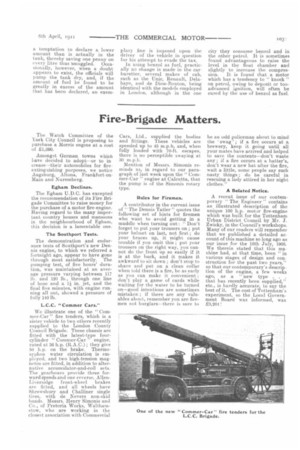Fire-Brigade Matters.
Page 15

If you've noticed an error in this article please click here to report it so we can fix it.
The Watch Committee of the York City Council is proposing to purchase a Morris engine at a cost of £1,090.
Amongst German towns which have decided to adopt—or to in crease—their automobiles for fireextinguishing purposes, we notice Augsburg, Altona, Frankfort-onMain and Nuremberg.
Egham Declines.
The Egham U.D.C. has excepted the recommendation of its Fire Brigade Committee to raisemoney for the purchase of a motor fire-engine. Having regard to the many important country houses and mansions in the neighbourhood of Egham, this decision is a lamentable one.
The Southport Tests.
The demonstration and endurance tests of Southport's new Dennis engine, to which we referred a fortnight ago, appear to have gone through most satisfactorily. The pumping test, of five hours' duration, was maintained at an average pressure varying between 117 lb. and 120 lb., through one line of hose and a 1i in. jet, and the final five minutes, with engine running all out, showed a pressure of fully 140 lb.
"Commer Cars."
We illustrate one of the " Comme.r-Car " fire tenders, which is a sister vehicle to two others recently supplied to the London County Council Brigade. These chassis are fitted with the latest-type fourcylinder " Commer-Car " engine, rated at 36 h.p. (It.A.C.); they give 56 h.p. on the brake. Thermosyphon water circulation is employed, and two high-tension magnetos are fitted, in addition to alternative accumulator-and-coil sets. The gearboxes provide three forward speeds and one reverse. AllenLiversidge front-wheel brakes are fitted, and all wheels have Shrewsbury and Challiner single tires, with de Nevers non-skid bands. Messrs. Henry Simonis and Co., of Pretoria Works, Walthamstow, who are working in the closest association with Commercial Cars, Ltd., supplied the bodies and fittings. These vehicles are speeded up to 45 in.p.h, and, when fully loaded with 70-ft. escapes, there is no perceptible swaying at 30 Mention of Messrs. Simonis reminds us, in regard to our paragraph of last week upon the " Commer-Car " engine at Calcutta, that the pump is of the Simonis rotary type.
Rules for Firemen.
A contributor in the current issue of The Dennis Tatler " quotes the following set of hints for firemen who want to avoid getting in a muddle when turning out : " Don't forget to put your trousers on ; put your helmet on last, not first ; do your braces up, it might cause trouble if you omit this ; put your trousers on the right way, you cannot do the front up so easily if it is at the back, and it makes it awkward to sit down ; don't stop to shave and put on a clean collar when told there is a fire, be as early as you can make it convenient ; don't play a game of cards while waiting for the water to be turned on—good intentions are sometimes mistaken ; if there are any valuables about, remember you are firemen not burglars—there is sure to
be an odd policeman about to mind the ' swag' ; if a fire occurs. at a. brewery, keep it going until all your mates have arrived and helped to save the contents—don't waste any ; if a fire occurs at a hatter's, don't wear a new hat after the fire, wait a little, some people say such nasty things ; do be careful in rescuing a lady attired in her night clothes."
A Belated Notice.
A recent issue of our contemporary The Engineer" contains an illustrated description of the unique 100 h.p. motor fire-engine which was built for the Tottenham Urban District Council by Mr. J. Zwicky, in the Council's workshops. Many of our readers will remember that we published a detailed account of this machine so long ago as our issue for the 16th July, 1908. We therein stated that this machine had, at that time, been "in various stages of design and construction for the past two years," so that our contemporary's description of the engine, a few weeks ago, as a "new type . . . that has recently been supplied," etc., is hardly accurate, to say the best of it. The cost of Tottenham's experiment, so the Local Government Board was informed, was £3,201!




















